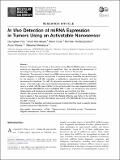| dc.contributor.author | Yoo, Byunghee | |
| dc.contributor.author | Kavishwar, Amol | |
| dc.contributor.author | Ross, Alana | |
| dc.contributor.author | Pantazopoulos, Pamela | |
| dc.contributor.author | Moore, Anna | |
| dc.contributor.author | Medarova, Zdravka | |
| dc.date.accessioned | 2016-11-07T18:18:45Z | |
| dc.date.available | 2016-11-07T18:18:45Z | |
| dc.date.issued | 2015-05 | |
| dc.identifier.issn | 1536-1632 | |
| dc.identifier.issn | 1860-2002 | |
| dc.identifier.uri | http://hdl.handle.net/1721.1/105229 | |
| dc.description.abstract | Purpose
The development of tools for the analysis of microRNA (miRNA) function in tumors can advance our diagnostic and prognostic capabilities. Here, we describe the development of technology for the profiling of miRNA expression in the tumors of live animals.
Procedures
The approach is based on miRNA nanosensors consisting of sensor oligonucleotides conjugated to magnetic nanoparticles for systemic delivery. Feasibility was demonstrated for the detection of miR-10b, implicated in epithelial to mesenchymal transition and the development of metastasis. The miR-10b nanosensor was tested in vivo in two mouse models of cancer. In the first model, mice were implanted subcutaneously with MDA-MB-231-luc-D3H2LN tumors, in which miR-10b was inhibited. In the second model, mice were implanted bilaterally with metastatic MDA-MB-231 and nonmetastatic MCF-7 cells. The nanosensors were injected intravenously, and fluorescence intensity in the tumors was monitored over time.
Results
We showed that the described nanosensors are capable of discriminating between tumors based on their expression of miR-10b. Radiant efficiency was higher in the miR-10b-active tumors than in the miR-10b-inhibited tumors and in the MDA-MB-231 tumors relative to the MCF-7 tumors.
Conclusions
The described technology provides an important tool that could be used to answer questions about microRNA function in cancer. | en_US |
| dc.description.sponsorship | National Institutes of Health (U.S.) (National Cancer Institute R01CA16346101A1) | en_US |
| dc.description.sponsorship | Breast Cancer Alliance (Young Investigator Award) | en_US |
| dc.publisher | Springer US | en_US |
| dc.relation.isversionof | http://dx.doi.org/10.1007/s11307-015-0863-3 | en_US |
| dc.rights | Article is made available in accordance with the publisher's policy and may be subject to US copyright law. Please refer to the publisher's site for terms of use. | en_US |
| dc.source | Springer US | en_US |
| dc.title | In Vivo Detection of miRNA Expression in Tumors Using an Activatable Nanosensor | en_US |
| dc.type | Article | en_US |
| dc.identifier.citation | Yoo, Byunghee et al. “In Vivo Detection of miRNA Expression in Tumors Using an Activatable Nanosensor.” Molecular Imaging and Biology 18.1 (2016): 70–78. | en_US |
| dc.contributor.department | Martinos Imaging Center (McGovern Institute for Brain Research at MIT) | en_US |
| dc.relation.journal | Molecular Imaging and Biology | en_US |
| dc.eprint.version | Author's final manuscript | en_US |
| dc.type.uri | http://purl.org/eprint/type/JournalArticle | en_US |
| eprint.status | http://purl.org/eprint/status/PeerReviewed | en_US |
| dc.date.updated | 2016-08-18T15:45:08Z | |
| dc.language.rfc3066 | en | |
| dc.rights.holder | World Molecular Imaging Society | |
| dspace.orderedauthors | Yoo, Byunghee; Kavishwar, Amol; Ross, Alana; Pantazopoulos, Pamela; Moore, Anna; Medarova, Zdravka | en_US |
| dspace.embargo.terms | N | en |
| mit.license | PUBLISHER_POLICY | en_US |
